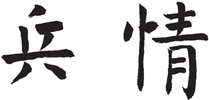10
Nature of the Army

“If you want to understand the nature of the army, the crossbow and arrows are the model. Arrows are the troops, the crossbow is the general. The one who releases them is the ruler. As for arrows, the metal is at the front, the feathers are at the rear. Thus they are powerful and excel in flight, for the front is heavy and the rear is light. Today in ordering the troops the rear is heavy and the front light, so when deployed in formation they are well ordered, but when pressed toward the enemy they do not obey. This is because in controlling the troops men do not model on the arrow.
“The crossbow is the general. When the crossbow is drawn, if the stock is not straight, or if one side of the bow is strong and one side weak and unbalanced, then in shooting the arrow the two arms will not be at one. Then even though the arrow’s lightness and heaviness are correct, the front and rear are appropriate, it still will not hit the target.
“If the general’s employment of his mind is not in harmony with the army, even though the formation’s lightness and heaviness are correct, and the front and rear are appropriate, they still will not conquer the enemy.
“Even if the arrow’s lightness and heaviness are correct, the front and rear are appropriate, the crossbow drawn straight, and the shooting of the arrow at one, if the archer is not correct, it still will not hit the target. If the lightness and heaviness of the troops are correct, the front and rear appropriate, and the general in harmony with the army, but the ruler does not excel, they still will not conquer the enemy.
Thus it is said for the crossbow to hit the objective it must realize these four. For the army to be successful there must be the ruler, the general, and the troops, these three. Thus it is said that an army conquering an enemy is no different from a crossbow hitting a target. This is the Tao of the military. If the model of the arrow is complied with, the Tao will be complete. When someone understands the Tao, the army will be successful, and the ruler will be famous.”
COMMENTARY
Although this chapter has suffered considerable damage, the extensive missing portions can be fairly well reconstructed because of the parallelism employed as Sun Pin develops his argument. The “Nature of the Army” emphasizes two points: first, attack formations must be powerful to the front; second, there must be coherence and unity among all members, and at all levels, of the command hierarchy.
In previous chapters Sun Pin has already asserted the importance of employing an elite, spirited front in order to explosively penetrate the enemy’s ranks. This section further justifies it with the analogy of the arrow with its metal point and therefore weight in the front, and the comparatively lighter feathers to the rear. However, this should not be viewed as an absolute principle, for earlier he had advocated withholding two thirds of the forces as a reserve capable of executing defensive and unorthodox tactics. But within the context of battlefield situations, his concept is clear: the necessary impact in an attack will be created by concentrating mass at the front of a chosen formation rather than retaining it in the rear.
The arrow analogy is further developed in terms of the crossbow and archer to illustrate the need for cooperation and harmony among all three, as well as for correctness to characterize them individually. If the general acts as the crossbow, then his tactics must be correct and balanced; otherwise, the troops will be used in an unbalanced fashion, defeat resulting. Furthermore, his intentions must penetrate to the officers and troops and they must be harmonized with him so that there will be no gaps or dissension. An image frequently employed by the military writers to concretely depict their relationship is that of the mind and the four limbs. For example, the Wei Liao-tzu states: “Now the general is the mind of the army, while all those below him are the limbs and joints. When the mind moves in complete sincerity, then the limbs and joints are invariably strong. When the mind moves in doubt, then the limbs and joints are invariably contrary. Now if the general does not govern his mind, the troops will not move as his limbs.”
The ruler, who stands as the archer in ultimately determining the campaign’s direction and objectives, must also be correct and presumably in harmony with the general. Since several of the ancient strategists, including Sun-tzu and Sun Pin, strongly condemned his interference once the commanding general had received his mandate, the question of the ruler’s correctness would primarily have reference to his role in the early councils that would determine the appropriateness and feasibility of undertaking military activities. This is why the general is the crossbow, rather than the archer, although the analogy cannot be pressed too far because he must become both the archer and bow in the field.
The implications for leaders concerned with establishing corporate or group direction are immediately apparent. Any perceptible inclination in the commander immediately, even unconsciously, translates into group orientation despite overt statements much to the contrary. Any bias or emotional deficit similarly affects fundamentals, including direction, interpretation, and effort. In sum, the commander must retain appropriate balance while clearly defining organizational tasks and committing resources to the project.